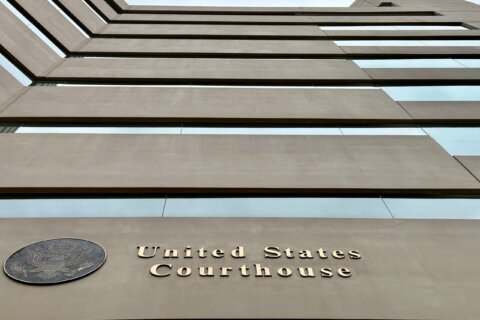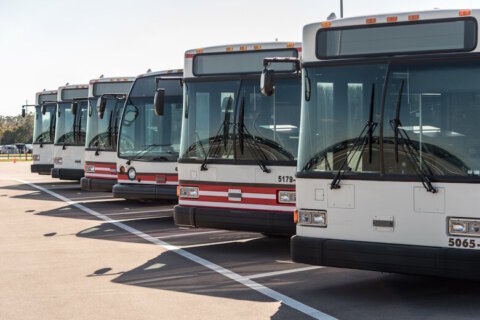This article was republished with permission from WTOP’s news partners at Maryland Matters. Sign up for Maryland Matters’ free email subscription today.
This content was republished with permission from WTOP’s news partners at Maryland Matters. Sign up for Maryland Matters’ free email subscription today.
U.S. EPA Administrator Andrew Wheeler on Wednesday accused the top attorneys from Maryland, Virginia and the District of Columbia of pursuing a “frivolous lawsuit” against his agency, warning that the legal action will hamstring efforts to clean up the Chesapeake Bay.
Wheeler testified Wednesday before the U.S. Senate Environment and Public Works Committee, days after Democratic Attorneys General Brian Frosh of Maryland, Mark Herring of Virginia and Karl Racine of Washington, D.C., announced plans to sue Wheeler for failing to ensure that Pennsylvania and New York meet water pollution standards set by the Chesapeake Bay Watershed Agreement in 2014.
“Nobody has failed to meet their obligations and they won’t until 2025, so these lawsuits are premature at best,” Wheeler told senators. “But to have to pull staff off of providing technical assistance to the Bay states in order to answer these quite frankly, frivolous lawsuits, is going to detract from getting our work done on cleaning up the Bay.”
Wheeler defended his agency’s work in response to questions from Maryland Democratic Sens. Benjamin L. Cardin and Chris Van Hollen.
“My concern is we’ve gotten messages from the EPA that you’re not going to act as the impartial observer here in enforcing what the states say they can do and science says that they’re able to do,” Cardin told Wheeler.
Lawmakers and environmental advocates have criticized Pennsylvania and New York for developing plans that fall short of meeting states’ 2025 cleanup goals. Earlier this year, EPA Chesapeake Bay Program Director Dana Aunkst worried watershed states when he described the 2025 deadline as “aspirational” and not legally enforceable.
Those comments, Wheeler said Wednesday, were “taken out of context.” He said that while EPA does not have the legal authority to enforce a total maximum daily load — limits on the allowable pollution each state can send to the Bay — EPA has other permitting authorities it can use to limit nitrogen and phosphorus pollution.
Van Hollen told Wheeler that lawmakers would have more confidence in the Trump administration’s commitment to Bay cleanup if the White House budget requests hadn’t sought to slash funding for the cleanup programs.
“We are now funding it on a bipartisan basis in Congress at $85 million a year. We actually increased it over the last year, and yet, the administration’s budget once again came in at $7.3 million, over a 90% cut,” Van Hollen said. “So it would boost our confidence in your statements of support if they were reflected in the budget.”
Van Hollen also warned that if Pennsylvania continues on its current trajectory, “there’s no way that it will meet the 2025 goals.” And although the compliance deadline for states is years off, “I think we all know that if a missile were fired and we had the ability to intercept it before we knew it was going to land in a bad place, we would do that.”
Wheeler insisted that the administration thinks the budget request is sufficient for the Chesapeake Bay cleanup program, adding that the agency also draws on funding from other areas.
Maryland, Wheeler said, is among the states that isn’t currently on track to meet its 2025 obligations. The state is late on complying with five permits, he said.
“Five states are currently not showing to meet their obligations by 2025. Pennsylvania and New York are of course two of them, but also Maryland is currently not set to meet their obligations by 2025 either,” Wheeler said. “But we are working with all of the states to make sure that they meet their obligations by 2025.”
Van Hollen replied that he’s aware that Maryland has “a stormwater issue” and is “working to fix it.” He said that “is not going to have any impact on our ability to meet our 2025 targets. So to compare Maryland’s issues” with stormwater to “the 25% shortfall in Pennsylvania really is apples to oranges.”
In a December 2019 evaluation of Maryland’s Watershed Implementation Plan, EPA wrote that “Maryland’s plan provides confidence … that it will attain the necessary load reductions by 2025.”
EPA wrote in its evaluation of Pennsylvania’s state’s plan, however, that it fell short of its goal to cut nitrogen, recognizing that Pennsylvania “has the largest loads to account for within the Chesapeake Bay.”
Cardin encouraged Wheeler to broadcast EPA’s plans to hold states accountable for their commitments. That “would go a long way to alleviating some of the concerns” that some states are doing their share while others are not, Cardin said.
EPA staff, Wheeler said, have put in 22,000 hours of technical assistance over the past year to states in order to help them comply with their cleanup plans.
“I was very surprised to see the Chesapeake Bay Foundation and the attorney generals for Maryland and Virginia announce that they’re going to sue the EPA over this,” Wheeler said.
A separate notice of intent to sue EPA also was sent this week by the Chesapeake Bay Foundation; the Maryland Watermen’s Association; Anne Arundel County; and Swoope, Va., cattle farmer and conservationist Robert Whitescarver.
Wheeler suggested Wednesday that the lawsuits were a waste of time. “If anything, I would hope that the Maryland attorney general would decide to work with his Department of Environmental Quality instead of pursuing a frivolous lawsuit,” he said.







